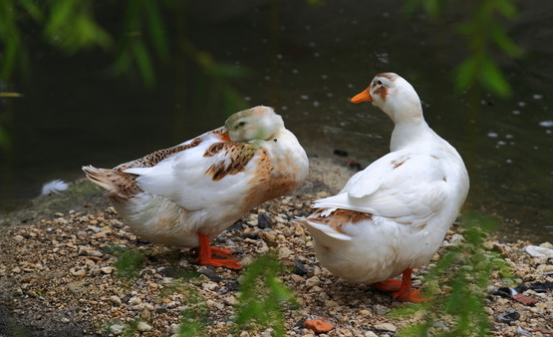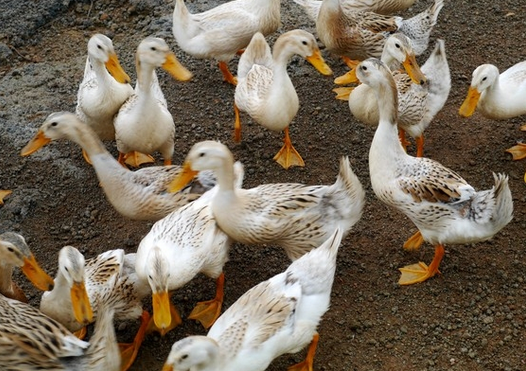In the winter, raising ducks is prone to high production costs, low survival rate and unsatisfactory economic benefits due to factors such as climate and environment. Therefore, there is often no profit in raising ducks in winter, so let's talk about a way to improve the profitability of duck farming in winter.
Hygiene and disinfection
Sanitary disinfection is an important part of the basic management of duck farming. In the winter, the weather changes, the weather is rainy and snowy, and the temperature drops, causing the duck's adaptability and body resistance to decrease. Therefore, sanitation and disinfection work must be timely, thorough and effective. Special attention should be paid to the environmental sanitation and disinfection of small and medium-sized duck houses to prevent infection of small and medium-sized ducks and poor growth in the early stage. Daily disinfection of the ducks in the medium and small duck houses is conducive to the purification of the ground, bedding and air of the duck house, preventing the small ducks from infecting the ducks with infectious serositis through the respiratory tract and damaged skin.
The living space of winter ducks is mostly indoors, and the cleanliness of indoor hygiene in duck houses is the key to solving the overall sanitary level of winter farming. Practice has proved that the dryness and hygiene of the bedding directly affects the weight gain and feed-to-meat ratio of commercial ducks. Wet bedding can produce a lot of ammonia, which causes air pollution in the duck house, which leads to the prevalence of disease in the ducks and affects growth and development.

Temperature and ventilation
Correctly solving and dealing with temperature, ventilation problems and the relationship between the two in winter will directly affect the overall production level. In general farms, insulation is mainly regulated by simple fires, agricultural membranes, etc. The indoor temperature of ducks of different ages should be strictly adjusted according to technical standards. Before 7 days of age, the temperature is 34 ° C ~ 27 ° C; 8 days ~ 21 days old, temperature 26 ° C ~ 18 ° C; 22 days old to the market, normal temperature (15 ° C ~ 20 ° C).
Ventilation should be determined according to the ammonia and carbon dioxide concentration of the duck house. Generally, the duck house is not irritated and difficult to breathe, and the temperature is appropriate. A small ventilation hole can be opened in the safety ventilation above the ceiling of the duck house for small airflow. Wind; if entering the duck house feels irritating and difficult to breathe, indicating that the concentration of ammonia and carbon dioxide in the air is too high, you should look for the reasons, such as the degree of dryness of the bedding, the hygienic condition of the drinking fountain, and disinfection. If there are any problems, it should be handled in time. At the same time, the ceiling ventilation facilities or ventilation holes should be opened to ventilate the airflow. The vertical and horizontal ventilation should not be avoided, causing the indoor temperature to suddenly drop, which leads to the ducks catching a cold.

Drinking water and water temperature control
Water is an essential substance in the process of duck growth. It should always be ensured that the ducks are provided with easy-to-eat, clean and hygienic drinking water, and at the same time pay attention to the temperature of the drinking water, especially the drinking water temperature of the duck during brooding. The ideal drinking water temperature for ducklings is between 20 °C and 25 °C; the ideal drinking water temperature for medium-sized ducks is 10 °C or slightly above. Don't let the ducks drink ice water in winter. If the amount of duck water is reduced, 24 to 28 hours will cause the duck to eat less, which will affect the growth rate, and the resistance of the ducks to the disease will be reduced accordingly.
The above methods to improve the income of duck farming in winter, for your reference, I hope to help you. Huinong School has more relevant agricultural technology knowledge. Continue to pay attention to Huinong School to answer questions during planting or breeding.
Copyright Tip: Hui Nongwang platform respects and protects intellectual property rights. If you find copyright problems in the platform articles, please contact us and handle them in time.
Disclaimer: Some of the content is reproduced from other media. The purpose of the reprint is to convey more information. It does not mean that the Hui Nongwang platform agrees with its views and is responsible for its authenticity.
Self Lock Plastic Pull Tight Seals
The Plastic Pull Tight Seals are adjustable length seals, have extra high strength with different lengths and they are designed for bag applications.
Applications: Bags (Mail, Canvas, Courier) etc.
The Plastic Pull Tight Seals featured with a flat wide strap or a round tail strap and a metal lock jaw. The material can be pp , pe , nylon etc.
The seals are easy to use, just a simple pull the seals are applied. The removal shall be with a cutter.
Standard Marking for the plastic pull tight seals are hot stamping, laser engraving etc.
Self Lock Plastic Pull Tight Seals,Plastic Pull Tight Seal,Plastic Pull Seal,Plastic Material Seals
Wenzhou Haoshi Light Industrial Products Co., LTD , https://www.economicseals.com